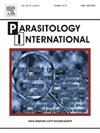Ultrastructural and phylogenetic characterization of some trematode cercariae emerging from the freshwater ampullariid snail, Lanistes carinatus (Olivier, 1804)
IF 1.9
4区 医学
Q3 PARASITOLOGY
引用次数: 0
Abstract
Ampullariid snails act as the first intermediate host for many intestinal parasites, such as Stomylotrmatidae, Phaneropsolidae, and Echinochasmidae. Both the Stomylotrmatidae and Phaneropsolidae families had the xiphidiocercariae type in their life cycle, while the Echinochasmidae had gymnocephalus cercaria type. Freshwater snails (Lanistes carinatus) were collected from Al-Inaniyyah, a village in the Damietta Governorate. The cercaria types were harvested by exposing the naturally infected snails to a strong artificial illumination for 2 h. This study added ultrastructure description and molecular structure of the 28S rRNA gene for the emerging cercariae types. This study included two types of cercariae that emerged from the freshwater snail Lanistes carinatus (xiphidiocercariae and gymnocephalus cercaria types). The oral sucker of the first type is armed with xiphoid-spine. While the oral sucker of the second type of cercariae was decorated with non-ciliated sensory papillae and is armed with spiny collar. The phylogenetic positions were inferred by the sequencing the 28S rRNA gene. The sequences of the xiphidiocercariae were linked to Stomylotrema pictum (family Stomylotrmatidae) and Phaneropsolus praomidis (family Phaneropsolidae), while, the sequence of the gymnocephalus cercariae was related to the family Echinochasmidae.
淡水壶腹蜗牛(Lanistes carinatus)中一些吸虫尾蚴的超微结构和系统发育特征(Olivier, 1804)。
壶腹螺是许多肠道寄生虫的第一中间寄主,如Stomylotrmatidae, Phaneropsolidae和Echinochasmidae。孔虫科和棘虫科的生活史中均有剑头尾蚴型,而棘虫科的生活史中均有裸头尾蚴型。在Damietta省的Al-Inaniyyah村收集了淡水蜗牛(Lanistes carinatus)。将自然感染的蜗牛暴露在强人工照明下2 h,收获尾蚴类型。本研究为新出现的尾蚴类型增加了28S rRNA基因的超微结构描述和分子结构。本研究包括从淡水蜗牛Lanistes carinatus中产生的两种类型的尾蚴(剑尾尾蚴和裸头尾蚴)。第一类口腔吸盘具有剑突棘。第二类尾蚴的口腔吸盘饰有无纤毛的感觉乳头,并配有刺状颈圈。通过对28S rRNA基因的测序推断其系统发育位置。剑头尾蚴的序列与pictum Stomylotrema (Stomylotrmatidae)和Phaneropsolus proomidis (Phaneropsolidae)有关,而裸头尾蚴的序列与棘球蚴科(Echinochasmidae)有关。
本文章由计算机程序翻译,如有差异,请以英文原文为准。
求助全文
约1分钟内获得全文
求助全文
来源期刊

Parasitology International
医学-寄生虫学
CiteScore
4.00
自引率
10.50%
发文量
140
审稿时长
61 days
期刊介绍:
Parasitology International provides a medium for rapid, carefully reviewed publications in the field of human and animal parasitology. Original papers, rapid communications, and original case reports from all geographical areas and covering all parasitological disciplines, including structure, immunology, cell biology, biochemistry, molecular biology, and systematics, may be submitted. Reviews on recent developments are invited regularly, but suggestions in this respect are welcome. Letters to the Editor commenting on any aspect of the Journal are also welcome.
 求助内容:
求助内容: 应助结果提醒方式:
应助结果提醒方式:


